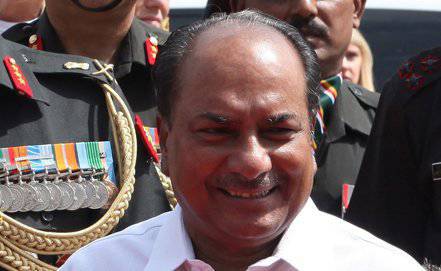Indian Defense Minister expressed dissatisfaction with the progress of a number of aviation programs
 Indian Defense Minister A.C. Anthony criticized the Defense Research and Development Organization (DRDO) for delaying several major aviation projects.
Indian Defense Minister A.C. Anthony criticized the Defense Research and Development Organization (DRDO) for delaying several major aviation projects.In particular, the Minister is not satisfied with the development program of the LJE "Tejas" light combat aircraft, the HJT-36 "Sitara" training aircraft, as well as the delay in the implementation of the tender for the replacement of Avro military transport aircraft HS-748.
According to Indian media reports, A. Anthony stated that the delay in the delivery of LCA "Tedzhas" aircraft to the troops is a real problem. He demanded to speed up this program, reduce the time for research, development and production of new machines. Currently, the project is delayed by more than 20 years.
The Minister of Defense also expressed concern about the delay in the development of the HJT-36 Sitara national training aircraft for the intermediate flight training.
As TSAMTO has already reported, the Indian Air Force has an acute shortage of training aircraft of all types, which affects the quality of pilot training.
The start of deliveries in 2007 by Hawke Control Center, the British company BAE Systems, made it possible to somewhat improve the in-flight training process (the “Stage 3”). However, the quality of pilot training at the initial stages of training with the use of outdated aircraft HPT-32 "Deepak" and HJT-16 "Kiran" does not meet modern requirements.
In order to get out of this situation, last year, 32 Swiss PC-75 Mk.7 was ordered to replace the HPT-2 “Deepak” for conducting training at “Stage.1”. The proposed HAL HTT-40 (Hindustan Turbo Trainer-40) did not suit India's MO in terms of cost and, moreover, its development has not yet been completed. Given this circumstance, the HTT-40 project is likely to be closed, and the remaining 106 machines will be built under a foreign license. Most likely, the option will be exercised with Pilatus Aircraft.
At the beginning of 2010 of the year, declaring the reality of the HTT-40 TCB development plan for initial training for 6 years, the leaders of the HAL referred to the successful development of the Intermediate Jet Trainer IJT (Intermediate Jet Trainer) project to replace the HJT TC -16 "Kiran" for the training of pilots at the "Stage.2".
The development of the IJT aircraft was sanctioned by the Indian government in 1999 with an initial budget of 1,8 billion rupees. The first flight of the TCB took place in March 2003. As reported, serial TCB IJT will receive the designation HJT-36 "Sitara". In total, HAL must produce for the Air Force and Indian Navy about 225 TCB of this type.
It was originally planned that the first batch of 12 IJT aircraft will be transferred to the Indian Air Force by the end of 2010. Nevertheless, according to A.Anthony, the project is constantly experiencing delays. All additional appropriations for the finalization of the aircraft have long been spent.
Referring to the tender for the purchase of 56 medium military transport aircraft to replace the obsolete HS-748 Avro, the minister said that, despite the objections of the HAL company, only private companies would be involved in the licensing project.
According to A.K. Antoni, if the program is completed successfully, then the country will create an optimal competitive environment in the aviation industry. At the moment, HAL is a monopolist in this market.
As TSAMTO has already reported, the Ministry of Defense of India at the end of November 2012 of the year issued a request for proposals for the supply of transport aircraft 56, intended to replace the HS-748 turboprop aircraft in service with the country's Air Force, built under the license of Hindustan Aerototix Limited (HAL). The Defense Procurement Council of the Ministry of Defense approved the project implementation last July. The tender will be officially announced in March of this year.
According to the terms of reference of the specification, a foreign bidder must select an Indian partner company to participate in the tender. The first 16 aircraft will be produced by a foreign supplier who will be selected as the winner of the tender, and the remaining 40 units. - built in India by its Indian partner company. In this case, 16% of components of national production should be used in the 40 design of 30 of these aircraft, and 24% of national components should be used in the production of 60 of the rest.
The first aircraft is scheduled to get through 4-5 years after the conclusion of a formal agreement. The total project cost is estimated at 2,5-3,0 billion dollars. The program is expected to increase the capacity of the national industry in the production of transport aircraft and attract additional private companies and investments to this market sector.
The new twin-engine aircraft must provide 6-8 tonnes of cargo, develop a cruising speed of 800 km / h (500 miles / h) and have a range of 2500-2700 km (1600-1700 miles).
According to reports, the Indian Air Force is armed with about 30 units. HS-748 carrying capacity up to 7 t. Aircraft operated from 1960-s. For the period from 1960 to 1983. HAL has released the HS-89 748.
As expected, the Indian Air Force will consider as candidates several aircraft, including the Russian Il-114, the Ukrainian An-148, the C-295 of the Airbus Militari company and the Italian C-27J Spartan.
Information